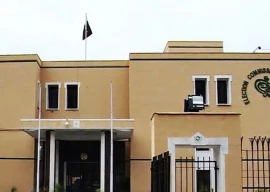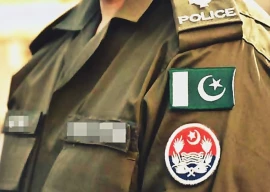
The mound is spread on 26 acres and is surrounded by the Devri village which got its name from the mound it engulfs. “Devri” is a Hindi word which means “top.” Legend has it that it could refer to the tall stupas – towers that were built with inscriptions of the Buddha when Buddhist kings ruled the subcontinent. Although the land revenue records name the place Junaj jo Daro and declare it to be inhabited by a Hindu community, Devri jo Daro is the more popular name.
According to the Bagranis the mound faces the threat of destruction. Another community, albeit a powerful one too – the Nizamanis, moved to the area after the floods. They have set up pickets on the mound and are destroying the artefacts, they say.
The people of Devri [Bagranis] resorted to protesting outside the office of the deputy commissioner of Badin district around ten days ago after their repeated complaints went unheard by the area SHO.
According to Shahnawaz Talpur, a resident, a team of the archaeology department had visited the mound and declared it to be a historical site. Yet another team came to visit the site two weeks ago, he said. But the Nizamanis did not let them in. However the team still managed to get a few samples and said that the mound might date back to the Mughal era. Even local journalists are not allowed near the site by the occupiers.
Another villager, Irfan Bagrani, said that he had a receipt given by the archaeology department. “We gave them four coins,” he said. “Some of the villagers had also met Sindh minister for culture, Sassui Palijo, on Thursday last week.” She had directed the Badin DPO to remove the illegal occupants, he added.
Another resident, Shahnawaz Talpur, said, “I found a coin after the recent rains [in September] and saw something inscribed on it in Arabic.” He said that often the villagers find coins, parts of broken pots, jewellery and other artefacts from the site usually after it rains every year.
He said that one can easily see how well planned the historical city was from the marks on the site. “One can judge how the people used to live and how their houses, markets and streets were built, he said. “There was also a mosque but I fear that these people will bulldoze it. The site is part of our cultural values and taught us how our ancestors used to live.” We should protect such sites, he urged.
A retired teacher, Sardar Ali Asghar, said that the ancient town dated back to before Islam arrived in the subcontinent. “It is possible that the city was built on a river and was prosperous,” he said. “We are not sure when and why it was destroyed. But it’s part of our history and we will protect it.”
The deputy director of archaeology department Hyderabad, Abdul Haque Bhambhro, was not aware of the issue. But he said that there were several such sites and his department was trying to investigate their importance.
“There is a process to declare an area as a historical site,” he said. “A team of experts first conducts a survey of the surface and then plans the excavation after a thorough study.”
The other sites Bhambro referred to are also present in Badin. They are Malyan Jo Daro, Kokal Jo Daro, Markhyan Jo Daro and Githo Jo Daro. They too, still await any step to preserve them.
Published in The Express Tribune, December 28th, 2011.
COMMENTS (1)
Comments are moderated and generally will be posted if they are on-topic and not abusive.
For more information, please see our Comments FAQ





























1713853507-0/MalalaHilary-(2)1713853507-0-270x192.webp)








goood efffooooort sir keeeep working hard for the sake of pakistan and to get rid of these land grabbbeeeerssssssssss